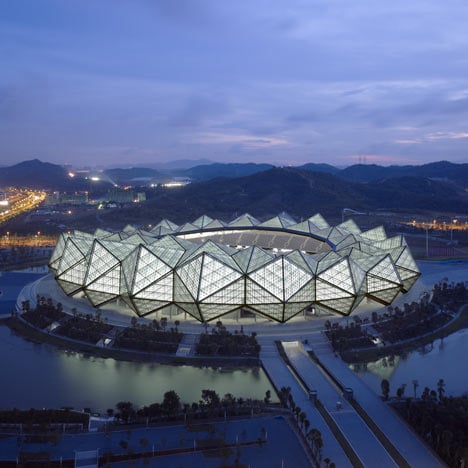Faceted glass triangles create glowing crowns around a trio of stadiums for the World University Games currently taking place in Shenzhen.
The three Universiade stadiums were designed by German studio GMP Architekten and surround an artificial lake.
The largest of the three buildings is the main events arena, which seats up to 60,000 spectators in three tiered stands.
The second stadium hosts indoor activities including ice skating and the third houses a swimming pool for aquatic events.
The closing ceremony for the games takes place on 23 August.
GMP Architekten have designed a number of stadiums for international competitions, including the recently published World Aquatics Championships complex in Shanghai - see all our stories about stadiums by GMP Architekten here.
Photography is by Christian Gahl.
Here are some more details from GMP:
2011 Universiade in Shenzhen
Inauguration of the Sports Center and Bao’an Stadium
To mark the occasion of the Universiade, which will take place from 12th to 23rd August 2011, the Universiade sports center and Bao’an stadium will be opened tomorrow in Shenzhen, southern China. The international com- petitions to come up with a design for the buildings were won in 2006 and 2007 by the designs of architects von Gerkan, Marg and Partners (gmp). The Universiade sports center consists of a stadium, a multifunctional hall and a swimming pool. The stadium in the Bao’an district is designed as an athletics stadium. However, during the 2011 Universiade, it is being used for football matches.
Universiades are World Games for students and are held every other year in winter and summer, hosted by the International University Sports Federation, the Fédération Internationale du Sport Universitaire (FISU). Going by the number of athletes participating, the summer Universiade is the second largest multi-sport event in the world after the Summer Olympics. It was announced in January 2007 that the 26th summer Universiade 2011 was to take place in Shenzhen.
Universiade 2011 Sports Center
The design for the Universiade Sports Center in the city of Shenzhen is inspired by the surrounding undulating landscape and generates a formal dialog that references Chinese horticulture and philosophy toward the land. The roof structure projects up to 65 m, and is designed as a steel prismatic shell on a basis of triangular fac- ets. The crystalline shape of the three stadia is additionally emphasized by the illumination of the translucent facades at night. An artificial lake connects the stadium with the circular multifunctional hall in the north and the rectangular swimming hall west thereof. The central sports plaza is accessed via a raised promenade from the individual stadia.
The main stadium is planned to be multifunctional, meeting the requirements of international sports occasions and events. Total capacity is 60,000, seated in three stands. The total diameter of the roof is 310 m lengthways and 290 m across.
The indoor sports complex is designed as a circular multifunctional arena for indoor sports competitions as well as for ice-skating and other events. The overall capacity is approx. 18,000 spectators. The swimming complex forms the third module of the Shenzhen Universiade Sports Center. The overall capacity is approx. 3,000 spectators, the seats are arranged on two stands.
Click above for larger image
Competition: 2006 – 1st prize
Design: Meinhard von Gerkan and Stephan Schütz with Nicolas Pomränke
Project: leader Ralf Sieber
Staff Xu: Ji, Alexander Niederhaus, Huang Cheng, Niklas Veelken, Martin Gänsicke, Stephanie Brendel, Marlene Törper, Andrea Moritz, Zheng Xin, Kralyu Chobanov, Chen Zhicong, Thomas Krämer, Lin Wei, Martin Schulte- Frohlinden, Plamen Stamatov, Christian Dorndorf, Lian Kian, Zhou Bin, Tobias Keyl, Li Ling, Helge Lezius, Meng Xin, Kuno von Haefen
Structural concept and design roof: schlaich bergermann und partner – Sven Plieninger with Wei Chen
Technical building equipment: IG Tech
Lighting design: Conceptlicht
Acoustics Acoustic Design: Ahnert
Facade planning: Shen and Partner
Chinese partner practices: SADI (stadium), CNADRI (multifunctional hall), CCDI (swimming hall), BLY (landscape design)
Client: Bureau of Public Works of Shenzhen Municipality
Seats, stadium: 60,000
Seats, multifunctional hall: 18,000
Seats, swimming hall: 3,000
Construction period: 2007–2011

